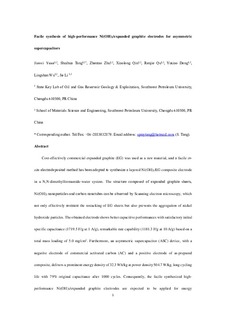| dc.contributor.author | Yuan, Jiawei | |
| dc.contributor.author | Tang, Shuihua | |
| dc.contributor.author | Zhu, Zhentao | |
| dc.contributor.author | Qin, Xiaolong | |
| dc.contributor.author | Qu, Renjie | |
| dc.contributor.author | Deng, Yuxiao | |
| dc.contributor.author | Wu, Lingshan | |
| dc.contributor.author | Li, Jie | |
| dc.contributor.author | Haarberg, Geir Martin | |
| dc.date.accessioned | 2018-01-26T08:55:45Z | |
| dc.date.available | 2018-01-26T08:55:45Z | |
| dc.date.created | 2018-01-09T13:20:39Z | |
| dc.date.issued | 2017 | |
| dc.identifier.citation | Journal of materials science. Materials in electronics. 2017, 28 (23), 18022-18030. | nb_NO |
| dc.identifier.issn | 0957-4522 | |
| dc.identifier.uri | http://hdl.handle.net/11250/2479773 | |
| dc.description.abstract | Cost-effective commercial expanded graphite (EG) was used as a raw material, and a facile in-situ electrodeposition method was adopted to synthesize a layered Ni(OH)2/EG composite electrode in an N,N-dimethylformamide-water system. Scanning electron microscopy images show that expanded graphite sheets, Ni(OH)2 nanoparticles and carbon nanotubes construct a layered structure, which not only effectively restrains restacking of EG sheets but also prevents aggregation of nickel hydroxide particles. The electrode delivers a satisfactory initial specific capacitance of 1719.5 F/g at 1 A/g with a total mass loading of 5.0 mg/cm2. Even at 10 A/g, the capacitance only decreases to 1181.3 F/g, showing a remarkable rate capability. Moreover, an optimized asymmetric supercapacitor (ASC) device was fabricated, in which the Ni(OH)2/EG electrode was used as a positive electrode and commercial activated carbon (AC) was used as a negative electrode. The ASC device can deliver a prominent energy density of 32.3 Wh/kg at power density 504.7 W/kg, and long cycling life with 79% original capacitance after 1000 cycles at 5 A/g, which can be prospective to be applied in practical devices for energy storage and conversion. | nb_NO |
| dc.language.iso | eng | nb_NO |
| dc.publisher | Springer Verlag | nb_NO |
| dc.title | Facile synthesis of high-performance Ni(OH)2/expanded graphite electrodes for asymmetric supercapacitors | nb_NO |
| dc.type | Journal article | nb_NO |
| dc.description.version | submittedVersion | nb_NO |
| dc.source.pagenumber | 18022-18030 | nb_NO |
| dc.source.volume | 28 | nb_NO |
| dc.source.journal | Journal of materials science. Materials in electronics | nb_NO |
| dc.source.issue | 23 | nb_NO |
| dc.identifier.doi | 10.1007/s10854-017-7745-1 | |
| dc.identifier.cristin | 1538784 | |
| dc.description.localcode | This is a pre-print of an article published in [Journal of Materials Science: Materials in Electronics]. The final authenticated version is available online at: https://link.springer.com/article/10.1007%2Fs10854-017-7745-1 | nb_NO |
| cristin.unitcode | 194,66,35,0 | |
| cristin.unitname | Institutt for materialteknologi | |
| cristin.ispublished | true | |
| cristin.fulltext | original | |
| cristin.fulltext | preprint | |
| cristin.qualitycode | 1 | |
